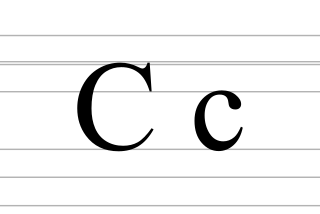
E, or e, is the fifth letter and the second vowel letter of the Latin alphabet, used in the modern English alphabet, the alphabets of other western European languages and others worldwide. Its name in English is e ; plural es, Es or E's.

G, or g, is the seventh letter of the Latin alphabet, used in the modern English alphabet, the alphabets of other western European languages, and others worldwide. Its name in English is gee, plural gees.

The International Phonetic Alphabet (IPA) is an alphabetic system of phonetic notation based primarily on the Latin script. It was devised by the International Phonetic Association in the late 19th century as a standardized representation of speech sounds in written form. The IPA is used by lexicographers, foreign language students and teachers, linguists, speech–language pathologists, singers, actors, constructed language creators, and translators.

N, or n, is the fourteenth letter of the Latin alphabet, used in the modern English alphabet, the alphabets of other western European languages, and others worldwide. Its name in English is en, plural ens.

O, or o, is the fifteenth letter and the fourth vowel letter of the Latin alphabet, used in the modern English alphabet, the alphabets of other western European languages and others worldwide. Its name in English is o, plural oes.

R, or r, is the eighteenth letter of the Latin alphabet, used in the modern English alphabet, the alphabets of other western European languages and others worldwide. Its name in English is ar, plural ars, or in Ireland or.

T, or t, is the twentieth letter of the Latin alphabet, used in the modern English alphabet, the alphabets of other western European languages and others worldwide. Its name in English is tee, plural tees.

Ezh, also called the "tailed z", is a letter, notable for its use in the International Phonetic Alphabet (IPA) to represent the voiced postalveolar fricative consonant. For example, the pronunciation of "si" in vision and precision, or the ⟨s⟩ in treasure. See also the letter ⟨Ž⟩ as used in many Slavic languages, the Persian alphabet letter ⟨ژ⟩, the Cyrillic letter ⟨Ж⟩, and the Esperanto letter ⟨Ĵ⟩.

The voiceless palato-alveolar sibilant affricate or voiceless domed postalveolar sibilant affricate is a type of consonantal sound used in some spoken languages. The sound is transcribed in the International Phonetic Alphabet with ⟨t͡ʃ ⟩, ⟨t͜ʃ ⟩⟨tʃ ⟩, or, in broad transcription, ⟨c⟩. The alternative commonly used in American tradition is ⟨č⟩. It is familiar to English speakers as the "ch" sound in "chip".
Unicode has subscripted and superscripted versions of a number of characters including a full set of Arabic numerals. These characters allow any polynomial, chemical and certain other equations to be represented in plain text without using any form of markup like HTML or TeX.

L, or l, is the twelfth letter of the Latin alphabet, used in the modern English alphabet, the alphabets of other western European languages and others worldwide. Its name in English is el, plural els.
The palatal hook (◌̡) is a type of hook diacritic formerly used in the International Phonetic Alphabet to represent palatalized consonants. It is a small, leftwards-facing hook joined to the bottom-right side of a letter, and is distinguished from various other hooks indicating retroflexion, etc. Theoretically, it could be used on all IPA consonant letters, – even on those used for palatal consonants, – but it is not attested on all of the IPA letters of its era. It was withdrawn by the IPA in 1989, in favour of a superscript j following the consonant.

Heng is a letter of the Latin alphabet, originating as a typographic ligature of h and ŋ. It is used for a voiceless y-like sound, such as in Dania transcription of the Danish language.

J, or j, is the tenth letter of the Latin alphabet, used in the modern English alphabet, the alphabets of other western European languages and others worldwide. Its usual name in English is jay, with a now-uncommon variant jy.

C, or c, is the third letter of the Latin alphabet, used in the modern English alphabet, the alphabets of other western European languages and others worldwide. Its name in English is cee, plural cees.
Unicode supports several phonetic scripts and notations through its existing scripts and the addition of extra blocks with phonetic characters. These phonetic characters are derived from an existing script, usually Latin, Greek or Cyrillic. Apart from the International Phonetic Alphabet (IPA), extensions to the IPA and obsolete and nonstandard IPA symbols, these blocks also contain characters from the Uralic Phonetic Alphabet and the Americanist Phonetic Alphabet.
Dz is a digraph of the Latin script, consisting of the consonants D and Z. It may represent, , or, depending on the language.

Dania is the traditional linguistic transcription system used in Denmark to describe the Danish language. It was invented by Danish linguist Otto Jespersen and published in 1890 in the Dania, Tidsskrift for folkemål og folkeminder magazine from which the system was named.
The Phonetic Symbol Guide is a book by Geoffrey Pullum and William Ladusaw that explains the histories and uses of the symbols of various phonetic transcription conventions. It was published in 1986, with a second edition in 1996, by the University of Chicago Press. Symbols include letters and diacritics of the International Phonetic Alphabet and Americanist phonetic notation, though not of the Uralic Phonetic Alphabet. The Guide was consulted by the International Phonetic Association when they established names and numerical codes for the International Phonetic Alphabet and was the basis for the characters of the TIPA set of phonetic fonts.
![]() ⟩.
⟩.![]() ⟩.
⟩.













